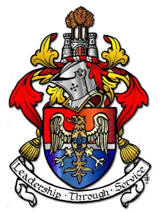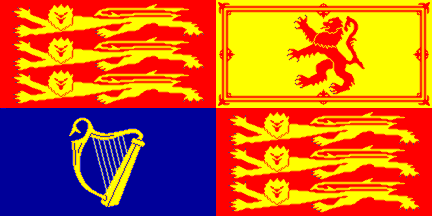
Royal Ancestors
from
England, Scotland and
Ireland
INTRODUCTION
There have been
kings and chieftains in Britain for at least three thousand
years, and probably much longer than that. It is unfortunate
that we do not know any of their names until the time of the
Roman invasion. Because of that, it is easy to believe that
there have only been kings since Julius Cesar.
Britain has been
occupied by man since the end of the last Ice Age, but it was
not until the New Stone Age, in about 300 BC, that a social
structure began to emerge that brought with it the need for more
powerful and organized leaders. These leaders were little more
than tribal chieftains, but they were imbued by their subjects
with something close to godhead. The connection between kings
and religion emerged very early in the development of kingship.
The Romans
established their own communities based largely upon the former
British tribes. Although they brought in their own Roman
administrators for these towns, they also married into the local
nobility and it is probable that descendants of the former
tribal chiefs served as senior government officials within a
Roman community.
By 388 Britain was n
longer a part of the Roman Empire. Britain like the rest of the
Roman frontier, was coming under increasing threat from the
Germanic tribes who, in 410, crossed the Rhine and invaded the
Empire.
The release of Roman
authority resulted in the spread of warfare across Britain. For
the most part it was a clash between tribes who sought to defend
and maintain the Roman status quo. But there was internal
fighting between the tribes who sought to gain power over the
old tribal territories. The period between 410 and 450 saw an
almost complete breakdown of the social order. Famine and
pestilence swept across Britain.
During this forty
years certain chiefs had become war leaders to defend their
lands and conquer enemies. These were regarded as kings by
their countrymen though they did not have quite the mystical
status in the pre-Roman era. The period of 450 to 550 is aptly
called the age of Arthur. Whoever this king was, he symbolized
the oppressive nature of the period.
By the late fifth
century and early sixth century a pattern was emerging as the
kingdoms gradually settled down. The Celtic chiefs had ruled a
tribe rather than land but by the start of the sixth century the
surviving Celtic rulers did establish territories for
themselves.
The transition from
squabbling tribe into kingdom is far from clear cut, but it is
evident that through the chaos a few strong British kingdoms
emerged. These were mostly in the north and west, because the
Saxon raids and settlements came from the east. The kingdoms we
know are those that survived the initial Saxon invasions and
were documented in the battles that followed as the Saxons and
Angles drove westward.
The Picts are a
complicated people to assess. They were Celtic, like the other
tribes, but seem to owe their origins to an earlier Irish
immigration around the third century BC. The Picts had
established an inheritance based on matrilinear succession. The
Picts were really an amalgamation of tribes.
One Iris settlement
changed the name of Pictland. This was Dál Riata, a kingdom
settled by the Irish of Dál Riata in Northern Ireland who came
across to Argyll and Kintyre and established a stronghold at
Dunadd.
Another major
northern British kingdom was Rheged. Its borders evidently
changed considerably depending upon the strength of its ruler.
The major surviving
kingdoms were in Wales. Although the Romans had infiltrated
southern Wales they never conquered north Wales and it is
certain that kings of the Ordovices continued to rule there.
Deheubarth did not
emerge until the tenth century. Two other Welsh kingdoms
existed in the fifth century: Powys and Gwent. Powys in eastern
Wales formed the border between Wales and England. Gwent is the
old kingdom of the Silures, and there are many ancient records
which suggest that the Silurian ruling family continued to
survive throughout Roman occupation.
These and other
smaller kingdoms held out against Saxon and Angles who began to
settle Britain from the middle of the fifth century.
Traditionally the first settlers were the Jutes in Kent under
Hengest invited to Britain by Vortigern to help in the battle
against the Picts. The remaining Saxons and Angles had to fight
to gain their territory. The British of the south may have
learned by the early sixth century that the only way to survive
was to join with the Saxons.
Around 500, the
Celts under Arthur established a bridgehead in central Britain
which for a generation or two held the Saxons at bay, but by 550
the latter were on the move again and under stronger leaders
with firmly established settlements down the east coast.
Between 550 and 600 the balance began to shift in southern and
central Britain away from the Celtic kingdoms to the Saxons.
Kent was the first
important kingdom in Saxon England and because of its position
of power and authority it was able to influence the other
kingdoms. The East Anglian kingdom emerged at about the same
time, in the 580s, and soon established itself. The East
Anglian kingdom crept close to the former kingdoms of the Iceni
and remained ferociously independent for over three hundred
years. The distant relatives of the East Anglian kings migrated
westward grouping to call themselves the Middle Angles who
established the kingdom of Mercia. The word Mercia means
borderland and is the same as the Welsh word Marches. The North
Angles were called Northumbrians. The Northumbrians had
tenaciously clung to the east coast of northern Britain for over
a century.
During the seventh
century, the English kingdoms of Mercia and Northumbria
dominated central and northern England, whilst Wessex and Kent
struggled to hold on to their power in the south. Northumbrian
power was broken in 685 with the death of Egfrith. Thereafter
the kingdom was ruled by weaker kings.
By the 850s the
Vikings were settled along the eastern Irish coast at Dublin and
Waterford. From there, in the short space of twenty years, they
conquered the Hebrides and the Isle of Man by the year 855,
Diera in 866, East Anglia in 869, the Orkneys by874 and
throughout the 870s encroached further into England.
The same process
that had unified England was working in Scotland, through more
haphazardly. The Celtic rule of partible succession meant that
kings divided their land amongst their sons so that the work of
any king to establish a stronger and larger kingdom was
immediately undone when it was subdivided amongst his
successors. This rule weakened the Welsh kingdoms more than the
Scottish, but it had its effect in the British kingdom of
Strathclyde, which had few strong kings.
The Scots of Dál
Riata had been growing in power, but then fell foul of an
interdynastic struggle between the ruling families. For a
period at the start of the eighth century this in-fighting
weakened the Scots and allowed the Picts to take control. The
Picts remained the dominant force for the next few generations
and the Dál Riata dynasty began to get the upper hand.
The Welsh kingdoms
also suffered from the rule of partible succession and from
there being too many children of Welsh kings. The whole history
of Wales from 500 to 1200 is one of constant fighting between
brothers, cousins, uncles, nephews and any other relative who
got in the way. Wales was not really a country of discrete
kingdoms. It was a country where the internal boundaries
changed with every passing king. The major struggles for power
were between Gwynedd in the north and Deheubarth in the south,
with Powys and Gwent occasionally getting in the way.
Although Scotland
(or Alba as it was then known) may have appeared to be one
kingdom with the arrival of Malcolm III, it was still divided.
The authority of the Scottish kings effectively covered the
lowlands and the Borders plus much of the eastern seaboard.
Orkney, Shetland, and the Western Isles, as far south as the
Isle of Man, were still answerable to the king of Norway whilst
the Highlands on the mainland where the people were Gaelic
speaking, regarded themselves as independent. It was only by
1493 that Scotland became the whole kingdom we would recognize
today.
Although the Normans
had dominated Wales and Scotland by the late thirteenth century,
they still regarded their heartland as Normandy and France
rather than England. England was a rich country, the revenues
from which allowed the kings to finance their campaigns in
France. The English kings retained the title “King of France”
from 1431 until 1801.
The War of the Roses
between the descendants of Edward III represented by the
dynasties of York and Lancaster, divided England between 1455
and 1487 and led to the succession of Henry Tudor, as Henry
VII. Tudor was of Welsh descent and one might argue that the
Welsh at last claimed the English throne, defeating the last of
the Plantagenets (the direct descendants of the Normans). The
Act of Union of 1536 formally absorbed Wales into the English
administrative and legal system. Another far-reaching event
happened in 1503 when the two royal families of Scotland and
England were united by marriage.
The history, and the
Heineman royal ancestors toed to the Plataganet family, follows
the remarkable ascent of an island, once divided among hundreds
of petty chieftains, to a united kingdom whose monarch had
authority over a fifth of the globe. The biographies of the
British royal ancestors that follow are annotated from Mike
Ashley’s, British Kings and Queens: The Complete Biographical
Encyclopedia of the Kings and Queens of Britain.
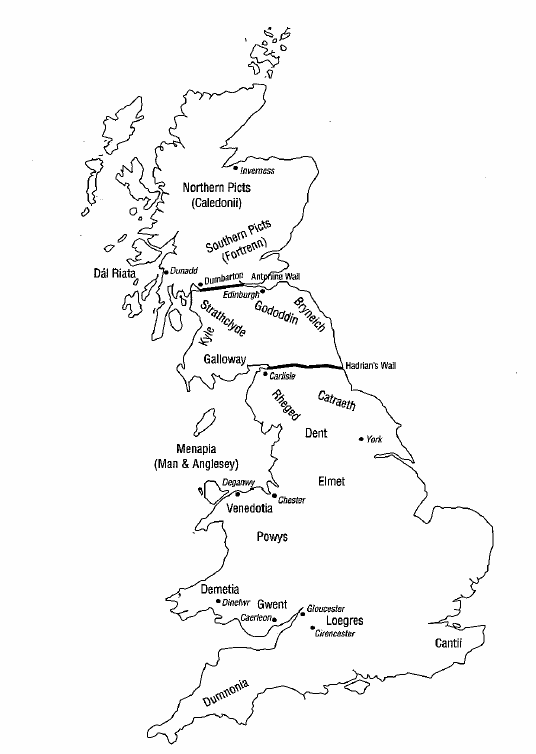
Emerging Post-Roman Kingdoms
Northern Britain
(Yorkshire to
the Clyde)
As
Britain emerged from the Roman Empire it fell to the leading
noblemen and generals to maintain law and order. A number of
leaders began to establish themselves in various corners of
Britain. The first were along the northern frontier, where Coel
the Old carved out a kingdom ruled by “the Men of the North.”
Their domain stretched from the northernmost Roman wall down to
what is now Yorkshire. After Coel’s death his kingdom was split
between his descendants and the rapidly subdivided, weakening
the realm. The kingdoms were gradually reduced by the Saxons,
although the British kingdom of Strathclyde survived much loner.
| Ruler/Ancestor |
Born |
Reign |
Died |
| Coel Hen The Old |
|
410-430 |
430 |
| Ceneu |
|
450-470 |
470 |
| Gurgust |
|
480-500 |
500 |
| Merchiaun Gul |
|
510-540 |
540 |
| Elidyr |
|
540-560 |
|
| Llwarch Hen |
|
560-595 |
640 |
Southern Britain
(England south of
Yorkshire)
Southern
Britain, the part that romantic legend has called Loegres, must
also have been divided into its former tribal status after Roman
departure, but it was less evident than in the north where
defenses were strongest against the Picts, Irish and Saxons.
Southern Britain retained, to a degree, the heart of the former
Roman administration and it is possible to se that there was an
attempt, at least for a while, to maintain a more cohesive
administration amongst the southern tribes probably based at the
heart of the wealthiest Roman centers around Cirencester and
Gloucester, where the tribes of Dobunni, Silures and Cornovii
mingled. It was probably from here that the primary leaders of
southern Britain emerged in what would later be the British
kingdoms of Gwent, Powys and the Gewisse, and it was from here
that the high kings, during the immediate post-Roman period
before the kingdoms began to establish themselves. The Welsh
Triads identify the first high kings as Owain, though his
existence is not otherwise recorded. The dates used are those
most commonly associated with the rulers, but are in themselves
dubious.
| Ruler/Ancestor |
Born |
Reign |
Died |
| Vortigern (Vitalinus) |
|
425-466 |
466 |
Demetia and Dyfed
The
kingdom of Dyfed, in the far south-west of Wales, was originally
the tribal territory of the Demetae, and the kingdom was first
known as Demetia. When Roman authority waned it was settled by
the Irish, who traced their descent from Artchorp in the fourth
century, who was descended from the Irish High Kings. Details
of the kings and their reigns are sparse. The Demetian rulers
are distantly related to the Scottish settlers of Dál Riata.
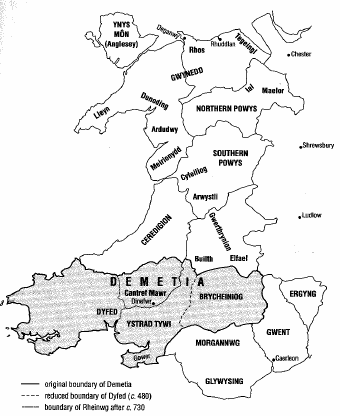
Welsh Kingdoms – Demetia and Dyfed
| Ruler/Ancestor |
Born |
Reign |
Died |
| Eochaid |
|
400 |
|
| Corath |
|
420s |
|
| Aed |
|
450s |
|
| Tryffin I Farfog "The Bearded" |
|
480s |
|
| Aircol Lawhir "Longhand" |
|
500 |
|
| Gwrthefyr (Vortepor) |
|
515-540 |
|
| Pedr |
|
570s |
|
| Anthwyr |
|
590s |
|
| Nowy |
|
610s |
|
Venedotia and Gwynedd
Gwynedd
covered the territory of the Ordovices, but the kingdom
established by Cunedda brought together migratory British from
elsewhere in Britain. The territory was originally known as
Venedotia, a name which mutated into Gwynedd over the next two
centuries. The heart of Gwynedd was originally at Deganwy, but
shifted to Anglesey and at one time included the Isle of Man.
It became the most powerful kingdom in Wales.
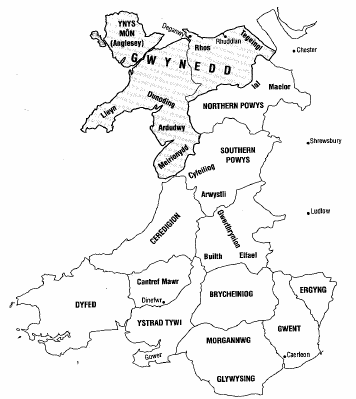
Welsh Kingdom - Gwynedd
| Ruler/Ancestor |
Born |
Reign |
Died |
| Cunedda |
|
450-460s |
|
| Einion |
|
470-480s |
|
| Cadwallon Lawhir "Longhand" |
|
500-534 |
534 |
| Maelgwn Hir "The Tall" |
497 |
520-549 |
549 |
| Rhun Hir |
520 |
549-580s |
|
| Beli |
|
580s-599 |
599 |
| Iago |
|
599-613 |
613 |
| Cadfan |
|
615-620 |
625 |
Edwin of Northumbria
overran Gwynedd between 620 and 627
| Ruler/Ancestor |
Born |
Reign |
Died |
| Cadwallon |
590 |
620-634 |
634 |
| Cadwaladr |
|
655-682 |
682 |
| Idwal |
|
682-720 |
720 |
| Rhodri Molwynog |
|
720-754 |
754 |
| Cynan |
|
798-816 |
816 |
| Merfyn Frych |
|
825-844 |
844 |
Powys and the Marches
The
kingdom of Powys was carved out of the lands of the Cornovii and
Decangii in eastern and north-eastern Wales. At the height of
its power, during the late sixth century, its boundaries
stretched beyond the curren border of Wales into Cheshire,
Stropshire and Herfordshire, the territory known today as the
Marches. It struggled to retain its independence since it was
under threat from the might of Gwynedd to the west and the
encroachment of the Mercians to the east. The identity of its
early rulers is uncertain because there was almost certainly
several tribes along the borders of Wales with no single
dominant ruler.
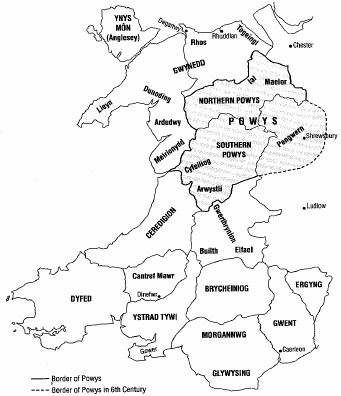
Welsh Kingdom – Powys
| Ruler/Ancestor |
Born |
Reign |
Died |
| Cyngen |
|
550s |
|
| Brochfael Ysgythrog |
|
570s |
|
| Cynan Garwyn |
|
600 |
|
| Eiludd ap Cynan |
|
615-? |
|
Northern Powys
(Chester, Clwyd)
| Ruler/Ancestor |
Born |
Reign |
Died |
| Beli ap Eiludd |
|
630s |
|
| Gwylog ap Beli |
|
700s |
|
| Elisedd ap Gwylog |
|
725-? |
|
| Brochfael ap Elisedd |
|
760s |
|
| Cadell ap Brochfael |
|
?-808 |
808 |
Gwerthrynion – Builth
This
small kingdom was in the center of Wales bounded by Powys,
Ceredigion and Brycheiniog. Like Powys, it developed from lands
once ruled by Vortigern in the mid fifth century. The name is
derived from Vortigern’s real name, Gwrtheyrn. The extent to
which it remained an autonomous kingdom is not clear. It may at
various stages have been subject to Powys, Brycheiniog, Gwent,
and Gwynedd. After Vortigern, it was ruled by is son Pascent.
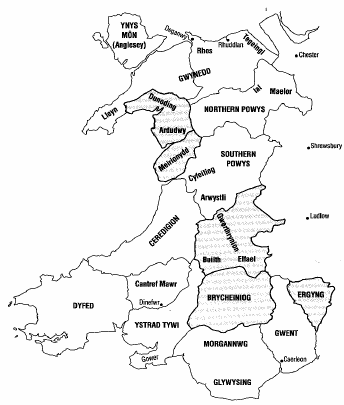
Minor Welsh Kingdoms
| Ruler/Ancestor |
Born |
Reign |
Died |
| Pascent |
|
640s |
|
The Dál Riata Scots
The
original “Scots” were Irish who came from the Dál Riata homeland
in northern Ireland and settled in Argyll. They gradually took
over most of Argyll, Galloway and the southern Hebrides until
the Viking invasions pushed them inland to conquer the kingdom
of the Picts. The Scots developed a genealogy taking their
pedigree back to 330 BC, based on their Irish ancestry. Listed
here are the Dál Riata Scottish Kings.
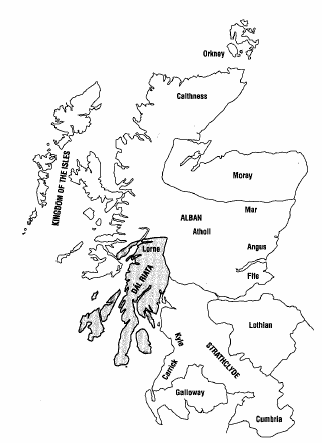
Scotland – Dál Riata
| Ruler/Ancestor |
Born |
Reign |
Died |
| Fergus "The Great" |
440 |
498-501 |
501 |
| Domgart |
|
501-507 |
507 |
|
Gabhrán |
|
538-558 |
558 |
| Eochaid Buide |
538 |
608-629 |
629 |
| Domnall Brecc |
|
629-642 |
642 |
| Domgart II |
|
660-673 |
673 |
| Eochaid II |
|
697 |
697 |
| Eochaid III |
|
726-733 |
733 |
| Aed Find "The Fair" |
|
750-778 |
778 |
| Eochaid IV "The Poisonous" |
|
781 |
|
| Alpin |
|
834 |
834 |
With the death
of Eoganan in 839, Kenneth MacAlpin united the Picts and the
Scots and the infant kingdom of Scotland (at first known as
Alba) emerged.
West Saxons (Gewisse
and Wessex)
It was
not until the late seventh century that Wessex began to take on
a unified shape. The West Saxons were a number of tribes who
conquered territory across the south of Britain. The main
concentration was in Wiltshire and Hampshire, but there was
another core of settlers along the Berkshire Downs. There was
considerable rivalry first with the British and then the
Mercians for territory in Glouchestershire and the Severn
Valley. Later the West Saxons began to push further west into
Somerset and Dorset. With territory fragmented and covering
such a spread of ground there would have been several kings at
any one time, not necessarily related, though later genealogists
sought to contain them in a single family tree. In fact the
West Saxons were a confederacy of tribes and adopted the name
Gewise, which means confederate but which originally related to
a British tribe or tribes in the area known as Ergyng or
Archenffield. It was not until the reign of Ine that these
tribes became united. Under Egbert they would become the
dominant kingdom, and the West Saxon dynasty became the rulers
of England.
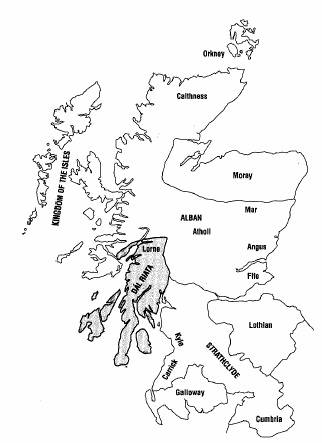
Anglo Saxon Kingdom - Wessex
| Ruler/Ancestor |
Born |
Reign |
Died |
| Cerdic |
|
538-554 |
554 |
| Cynric |
|
554-581 |
581 |
| Caewlin |
|
581-588 |
589 |
| Cutha |
|
570-580 |
|
| Egbert |
771 |
802-839 |
839 |
| Athelwolf |
795 |
839-855 |
858 |
| Athelred I |
837 |
865-871 |
871 |
| Alfred "The Great" |
849 |
871-899 |
899 |
By the time of
Alfred the West Saxons had imposed their authority over the rest
of England, but the nation had again become riven by the Danish
invasions and the fight for Britain began.
Deheubarth
Deheubarth came into existence in 920 when Hywel Dda combined
the former kingdoms of Dyfed and Seisyllwg. Occasionally rulers
of Deheubarth gained control over Gwynedd and vice versa. The
Normans conquered Deheubarth in 1093, though descendants of the
ruling family were allowed to hold authority over Cantref Mawr
“The Great Cantref” and Ystrad Tywi and from this base the
former kingdom of Deheubarth briefly re-emreged in the twelfth
century under Maredudd ap Grufydd and the Lord Rhys. Thereafter
Norman control was re-exerted and Deheubarth ceased to exist as
a kingdom after 1234.
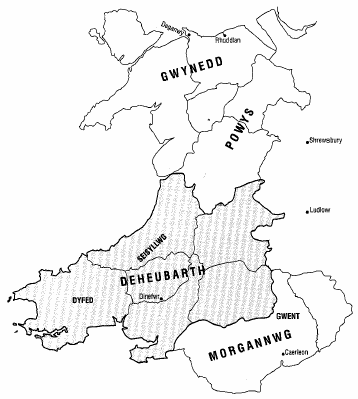
Later Welsh Kingdoms
| Ruler/Ancestor |
Born |
Reign |
Died |
| Hywel Dda "The Good" |
882 |
920-950 |
aft. 950 |
Hywel’s death
Gwynedd regained its independence. Hywel’s three sons split the
kingdom of Deheubarth but after Rhodri died in 953 and Edwin in
954, Owain was able to reconsolidate them.
| Ruler/Ancestor |
Born |
Reign |
Died |
| Owain ap Hywel |
|
954-986 |
988 |
| Maredudd ab Owain |
|
986-999 |
999 |
| Rhys ap Tewdwr |
|
1078-1093 |
1093 |
The Kingdom of Gwynedd
Gwynedd
was always the primary kingdom of Wales, even though it had
moments when it was dominated by rulers from the south. It had
several great rulers during its early years but the first to
earn the title of “The Great” was Rhodri ap Merfyn who by 871
had inherited Powys and Seisyllwg, in addition to Gwynedd, and
was effectively ruler of all northern and western Wales.
| Ruler/Ancestor |
Born |
Reign |
Died |
| Rhodri Mawr "The Great" |
|
844-878 |
878 |
Rhodri succeeded to
the kingdom of Powys in 855 and Seisllwg in 871, becoming king
of all North Wales.
| Ruler/Ancestor |
Born |
Reign |
Died |
| Anarawd ap Rhodri |
|
879-916 |
916 |
| Idwal Foel "The Bald" |
|
916-942 |
942 |
Idwal submitted to
Edward the Elder of England from 918-937. Gwynedd was ruled by
Hywel Dda of Deheubarth from 942-950,
| Ruler/Ancestor |
Born |
Reign |
Died |
| Iago ap Idwal ap Meurig |
|
1023-1039 |
1039 |
| Grufydd ap Cynan |
1055 |
1081-1137 |
1137 |
| Owain Gwynedd |
1100 |
1137-1170 |
1170 |
Upon Owain’s death
his lands were divided between his sons.
| Ruler/Ancestor |
Born |
Reign |
Died |
| Llwelyn "The Great" |
1173 |
1195-1240 |
1240 |
Medieval Powys
For over
two hundred years Powys formed part of the kingdom of Gwynedd.
It was re-established as a separate kingdom by the sons of
Bleddyn ap Cynfyn soon after 1075 and although it was later
divided into Northern and Southern Powys, it remained
independent for two centuries until eventually possessed by
England.
| Ruler/Ancestor |
Born |
Reign |
Died |
| Maredudd ap Bleddyn |
|
1116-1132 |
1132 |
| Madog ap Maredudd |
|
1132-1160 |
1160 |
After Madog’s death,
the kingdom was divided into North and South.
Scotland
In 848 Kenneth
macAlpin united the kingdoms of the Picts and the Scots which
later became known as Scotland. At this stage the kingdom was
centered at Forteviot in southern Scotland and Kenneth and his
successors held little authority over the highlands which were
still dominated by the Cenél Loarn and the Picts who later
emerged as the separate kingdom of Moray. Further north the
Vikings settled in Orkney and their authority spilled over into
Caithness. It was centuries before Scotland became united.
Only in 1265 did Norway cede the sovereignty of the Western
Isles and Man to Scotland and, though the earldom of Orkney
passed into the hands of a Scottish family it remained Norwegian
territory for another two centuries. It was ironic, therefore,
that at the time that Scotland began to feel it had control over
its affairs, Alexander III should die with only an infant
successor and her death left the country with a succession
crisis. The country fell into the hands of the English King
Edward I.
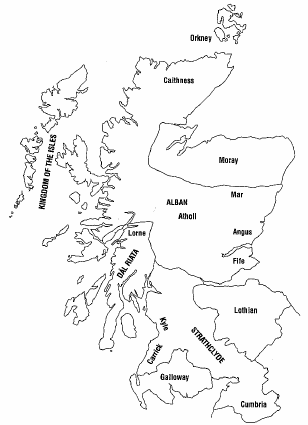
Scotland 500-1200
| Ruler/Ancestor |
Born |
Reign |
Died |
| Kenneth macAlpin I |
|
840-858 |
858 |
| Constantine I |
|
863-877 |
877 |
After 878 the
kingdom of the Picts, Dál Riata and Strathclyde were united
under one monarch, the first to be honored as King of Scotland.
| Ruler/Ancestor |
Born |
Reign |
Died |
| Donald II |
|
889-900 |
900 |
| Malcolm I |
|
943-954 |
954 |
| Kenneth II |
|
971-995 |
995 |
| Malcolm II |
954 |
1005-1034 |
1034 |
| Duncan |
1001 |
1034-1040 |
1040 |
| Malcolm III Canmore |
1031 |
1058-1093 |
1093 |
| David I "The Saint" |
1084 |
1124-1153 |
1153 |
| William I "The Lion" |
1143 |
1165-1214 |
1214 |
Western Isles
(Hebrides and the
Isle of Man)
The
Hebrides and the Isle of Man formed a kingdom known as the
Western Isles to the Scots and the Southern Isles (or Sundreys)
to the Norse. Identifying sovereignty over them is
complicated. The islands were occupied by both the Irish and
British during the various waves of invasion around the first
century BC and AD. Legend attributes names to four early Celtic
rulers of Man who may have some basis in fact – Dalboeth,
Elathan, Alldh or Athas, and Manannan. Manannan’s name is most
closely associated with the island. During the fifth century
Man came under the control of the rulers of Rheged. It was
conquered by Edwin of Northumbria in 620, but its rulership
remained with the descendants of Llywarch Hen until it passed
briefly to Wales and was then conquered by the Danes.
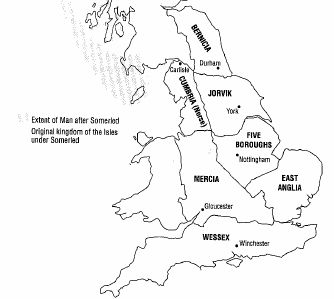
Kingdoms of Man and the Isles
| Ruler/Ancestor |
Born |
Reign |
Died |
| Llywarch Hen |
|
560-595 |
|
Man was conquered by
Baetan mac Cairill of Ireland in 577 and then by Aedan mac
Gabhran of Dál Riata in 582. It may have remained under
Scottish domination until conquered by Edwin of Northumbria in
620.
| Ruler/Ancestor |
Born |
Reign |
Died |
| Diwig |
|
600s |
|
| Gwyr |
|
630s |
|
| Tegid |
|
670s |
|
| Sandde |
|
730s |
|
| Gwriad |
|
800s |
|
Gwriad’s son, Merfyn
Frych, became king of Gwynedd and Man in 825, but Man soon
slipped out of his hands. By the 830’s, the Western Isles were
being settled by Vikings and the Hiberno-Norse Gael-Gaedhil.
The English and Normans (900-1284)
Although
Alfred the Great held the Danes at bay and stopped a total
conquest of England, they were granted land in East Anglia and
Danish settlements rapidly grew. A foothold had been
established. Danish and Norse raids continued and they were
eventually victorious in 1013 when the English capitulated to
Swein Forkbeard. After his death his son Canute became one of
the great rulers of northern Europe. Even though Canute’s sons
were unable to sustain the scale of his empire, it was not the
last England saw of the Northmen. Another branch of the ancient
royal family, related to the earls of Orkney, had settled in
Normandy, and their leader, William the Bastard, conquered
England in 1066. The Northmen were ultimately victorious and
drove the Saxons into serfdom. It was this generation of
Northmen, William’s sons and grandsons, that not only conquered
England but dominated Wales and Scotland. Although Scotland was
not quite conquered, Edward I died believing it was within his
grasp, just like Wales, which he had dominated and absorbed into
England in 1284. By the reign of Edward I Britain was fast
becoming a united kingdom with the English king recognized as
the sovereign lord.
| Ruler/Ancestor |
Born |
Reign |
Died |
| Edward "The Elder |
871 |
899-924 |
924 |
| Edmund I |
921 |
939-946 |
946 |
| Edgar "The Peaceful" |
943 |
959-975 |
975 |
| Athelred II |
896 |
978-1013 |
1016 |
In 1013 the Dunelaw
submitted to Swein, king of Denmark.
| Ruler/Ancestor |
Born |
Reign |
Died |
| Athelred II |
968 |
1014-1016 |
1016 |
| Edmund II "Ironside" |
989 |
1016 |
1016 |
| Edward |
1004 |
104201966 |
1066 |
| Harold II |
1022 |
1066 |
1066 |
THE HOUSE OF
NORMANDY
William of
Normandy gained the throne of England by conquest. The Saxon
royal family was overthrown and a new regime was imposed which
changed England forever.
| Ruler/Ancestor |
Born |
Reign |
Died |
| William "The Conqueror" |
1027 |
1066-1087 |
1087 |
| Henry I |
1068 |
1100-1135 |
1135 |
| Stephen |
1097 |
1135-1154 |
1154 |
THE HOUSE OF ANJOU (Plantagenet)
| Ruler/Ancestor |
Born |
Reign |
Died |
| Henry II |
1133 |
1154-1189 |
1189 |
| John Lackland |
1167 |
1199-1216 |
1216 |
| Henry III |
1207 |
1216-1272 |
1272 |
England and Great Britain
from Edward I
Civil war
split England three times between the Norman Conquest in 1066
and the death of Henry III. With Edward I came the first strong
king able to unite England and institute what became known as
the Model Parliament in 1295. Edward also conquered Wales and
sought to do the same for Scotland, but found it harder to
subdue the Scottish nation and died before the kingdoms were
united. It would not be until 1603, with the death of Elizabeth
I, that Scotland and England were ruled by the same monarch, and
not until the Act of Union in 1707 that the United Kingdom was
officially created.
back to

index
